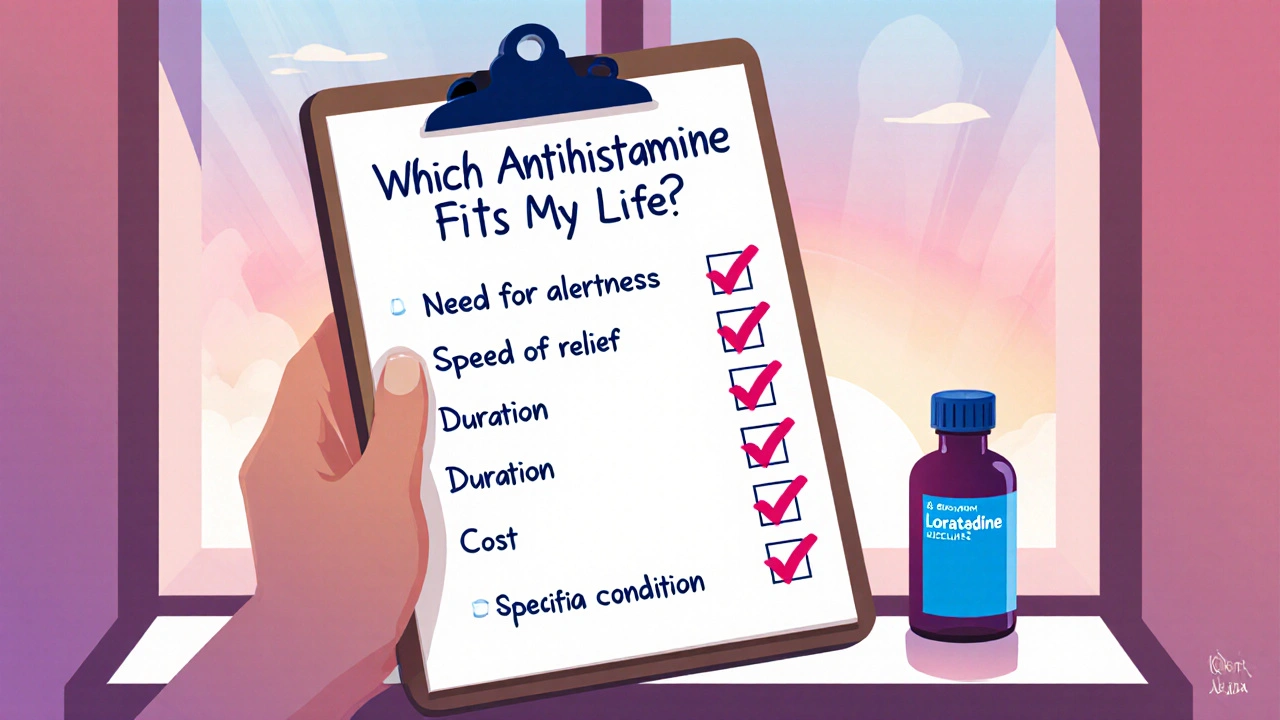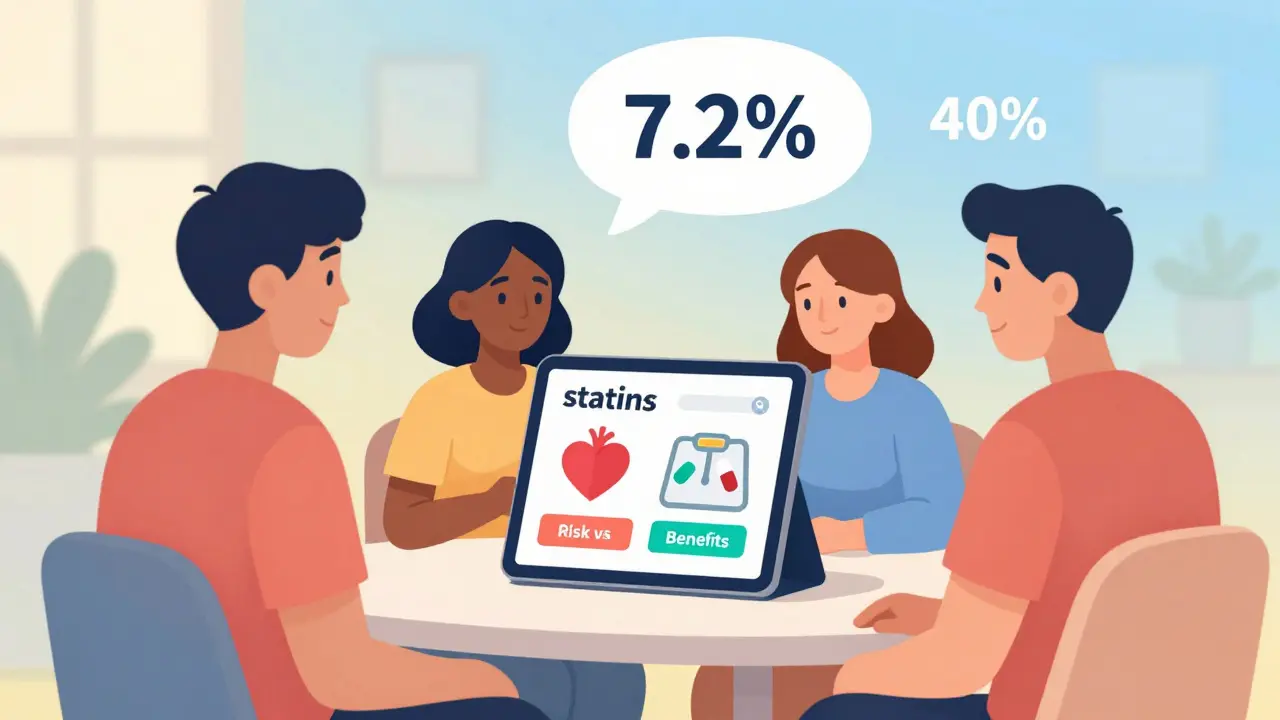Allergy season can turn a pleasant day into a constant battle with sneezing, watery eyes, and itchy skin. You’ve probably reached for an over‑the‑counter pill, but the market is flooded with options. How do you know whether loratadine, cetirizine, fexofenadine or another antihistamine will give you the relief you need without unwanted side effects? This guide breaks down the science, the pros and cons, and hands you a practical checklist so you can pick the right drug for your life.
How Antihistamines Work
Allergic reactions are triggered when the immune system releases histamine, a molecule that binds to H1 receptors in the nasal passages, eyes, and skin. The binding causes blood vessels to dilate, mucus to surge, and nerves to fire, producing the classic sneezing‑itch‑runny‑nose combo. Antihistamines block those H1 receptors, preventing histamine from delivering its signal.
There are two generations of H1‑antihistamines. First‑generation drugs (like diphenhydramine) cross the blood‑brain barrier and often cause sedation. Second‑generation agents (loratadine, cetirizine, fexofenadine, levocetirizine, desloratadine) are designed to stay out of the brain, delivering symptom relief with minimal drowsiness.
Loratadine - What Sets It Apart?
Loratadine is a second‑generation H1‑antihistamine that provides 24‑hour relief from sneezing, itching, and runny nose without the heavy sedation typical of older drugs. Approved by the FDA in 1993, it’s available in 10 mg tablets, liquid drops, and even chewable tablets for kids.
- Onset of action: 1-3 hours
- Duration: Up to 24 hours
- Typical dose: 10 mg once daily for adults
- Pregnancy category: B (generally considered safe)
- Common side effects: mild headache, dry mouth, rare fatigue
Because it is metabolized by the liver enzyme CYP3A4, loratadine can interact with certain antifungals, macrolide antibiotics, and some antidepressants. If you’re on multiple prescriptions, a quick chat with your pharmacist can prevent unwanted interactions.
Other Popular Second‑Generation Antihistamines
Below are quick snapshots of the most commonly used alternatives.
Cetirizine is another second‑generation antihistamine that tends to be a touch more potent than loratadine, but it may cause mild drowsiness in up to 10 % of users.
Diphenhydramine belongs to the first‑generation class. It’s extremely effective for short‑term allergy relief and nighttime use, but its sedative effect makes it unsuitable for daily activities.
Fexofenadine is prized for its near‑zero sedation profile and rapid onset (as fast as 30 minutes). However, it must be taken on an empty stomach for optimal absorption.
Levocetirizine is the active enantiomer of cetirizine, delivering similar potency with a slightly lower dose. It’s a good option for people who need stronger control without much drowsiness.
Desloratadine is the primary metabolite of loratadine. It works a bit longer (up to 26 hours) and is often marketed for chronic urticaria as well as seasonal allergies.
Side‑by‑Side Comparison
| Antihistamine | Onset | Duration | Sedation Risk | Typical Adult Dose | Pregnancy Category |
|---|---|---|---|---|---|
| Loratadine | 1-3 h | 24 h | Low | 10 mg QD | B |
| Cetirizine | 1 h | 24 h | Low‑moderate (≈10 % drowsy) | 10 mg QD | B |
| Fexofenadine | 30 min | 12-24 h | Very low | 180 mg BID or 180 mg QD | B |
| Levocetirizine | 1 h | 24 h | Low‑moderate | 5 mg QD | B |
| Desloratadine | 1-3 h | 26 h | Low | 5 mg QD | C |
| Diphenhydramine | 15 min | 4-6 h | High | 25-50 mg Q4‑6h PRN | C |
The table makes it clear that loratadine sits comfortably in the low‑sedation, 24‑hour category, but it isn’t the only player. Your choice should hinge on a few personal factors.
Decision‑Making Checklist: Which Antihistamine Fits Your Lifestyle?
- Need for alertness: If you drive or operate machinery, steer clear of first‑generation drugs and consider loratadine, fexofenadine, or desloratadine.
- Speed of relief: For rapid onset (under an hour), fexofenadine or diphenhydramine are the quickest.
- Duration requirements: For once‑daily dosing, loratadine, cetirizine, levocetirizine, and desloratadine all cover a full day.
- Cost considerations: Generic loratadine and cetirizine are usually the cheapest; brand‑name fexofenadine can be pricier unless you find a store‑brand version.
- Medical interactions: Review your medication list. Loratadine and cetirizine share CYP3A4 metabolism, while fexofenadine isn’t metabolized by the liver and thus has fewer drug‑drug clashes.
- Specific condition: Chronic urticaria often responds better to desloratadine or higher‑dose cetirizine, while seasonal allergic rhinitis is well‑handled by any second‑generation agent.
By ticking these boxes, you can narrow the field without endless trial and error.

Practical Tips for Safe Use
- Take the pill with water, not with a heavy meal, unless the label advises otherwise (fexofenadine needs an empty stomach).
- Don't double‑dose if a dose is missed; just resume the regular schedule.
- If you notice persistent headache, dry mouth, or unexpected drowsiness, switch to a different antihistamine and monitor the change for a few days.
- Children under 2 years should not receive loratadine without pediatric guidance. Most products have child‑specific formulations starting at 5 mg.
- Pregnant or breastfeeding individuals should discuss options with their healthcare provider; loratadine (Category B) is generally safe, while diphenhydramine (Category C) requires caution.
Remember, antihistamines treat symptoms, not the underlying allergy. If you keep needing a daily pill for months on end, consider seeing an allergist for possible immunotherapy.
Frequently Asked Questions
Is loratadine truly non‑drowsy?
For most adults, loratadine causes little to no sedation. A small percentage (1‑2 %) may feel mild tiredness, but it’s far less than the 50‑% drowsiness rate seen with diphenhydramine.
Can I take loratadine with alcohol?
Mixing loratadine with moderate alcohol is generally safe, but heavy drinking can amplify any mild sedation you might feel. Keep it light and stay aware of your own tolerance.
How does loratadine compare to cetirizine for chronic hives?
Cetirizine often provides a stronger anti‑hive effect, but the trade‑off is a slightly higher chance of drowsiness. If you need daytime relief and can tolerate mild sleepiness, cetirizine may be preferred; otherwise, stick with loratadine or try desloratadine.
Is it okay to switch between antihistamines?
Yes. Many people rotate between loratadine, cetirizine, and fexofenadine to see which works best for their symptoms. Just give each drug a few days to gauge effectiveness before changing.
What should I do if I miss a dose?
Take the missed loratadine dose as soon as you remember, unless it’s almost time for the next scheduled dose. In that case, skip the missed one-don’t double‑dose.
Armed with this comparison, you can decide whether loratadine or another antihistamine is the best antihistamine for your daily routine. Choose wisely, stay consistent, and enjoy clearer days ahead.







Jennie Smith
October 25, 2025 AT 16:31Hey folks, great rundown! I love how you laid out the checklist – it makes the decision feel like a simple game of tick‑boxes. If anyone’s juggling kids and work, the chewable loratadine for kids really saves a trip to the pharmacy. Remember to keep a glass of water handy; it helps the tablet dissolve faster.
Stay sneeze‑free!
Greg Galivan
November 1, 2025 AT 14:11Loratadine works, period.
Anurag Ranjan
November 8, 2025 AT 12:51Loratadine is non‑sedating for most adults. It’s a solid first choice if you need all‑day relief.
James Doyle
November 15, 2025 AT 11:31The pharmacodynamic profile of loratadine exemplifies the evolution from first‑generation antihistamines to a truly selective H1‑receptor antagonist.
By avoiding central nervous system penetration, it mitigates the histaminergic sedation cascade that plagues diphenhydramine.
Clinical trials consistently demonstrate a median onset of 1.5 hours, aligning with the therapeutic window needed for acute allergen exposure.
Moreover, its 24‑hour half‑life permits once‑daily dosing, reducing medication fatigue and improving adherence.
From a safety standpoint, loratadine exhibits a favorable adverse‑event spectrum, with headache and dry mouth appearing in less than 5 % of subjects.
The metabolic pathway via CYP3A4, while generally benign, does warrant caution when co‑administered with potent inhibitors such as ketoconazole.
In pediatric populations, the chewable formulation maintains bioequivalence, ensuring that children receive comparable symptom control without dosing errors.
Comparative studies reveal that cetirizine may exhibit marginally higher H1‑receptor occupancy, yet the trade‑off includes a measurable increase in daytime somnolence.
Fexofenadine, on the other hand, offers a rapid 30‑minute onset but requires an empty stomach, a practical limitation for many patients.
Desloratadine extends the duration to approximately 26 hours, making it a viable option for chronic urticaria where sustained suppression is paramount.
The economic aspect cannot be ignored; generic loratadine often undercuts brand‑name counterparts, delivering cost‑effective relief.
Pharmacoeconomic analyses suggest that the incremental cost per quality‑adjusted life year is negligible, supporting its position as a first‑line OTC agent.
Patient‑reported outcomes consistently rank loratadine high on convenience and minimal cognitive impairment, essential criteria for individuals operating machinery.
From an ethical perspective, prescribing a non‑sedating antihistamine aligns with the principle of non‑maleficence, avoiding iatrogenic drowsiness.
In summary, loratadine embodies the balance of efficacy, safety, and practicality that modern allergy management strives for.
Edward Brown
November 22, 2025 AT 10:11Sure, the science sounds solid but have you considered that big pharma might be hiding longer‑lasting formulas from us? The whole CYP3A4 story feels like a convenient excuse for them to push brand names.
Stay skeptical, friends.
ALBERT HENDERSHOT JR.
November 29, 2025 AT 08:51While it’s easy to jump to conspiracy, the FDA’s review process actually involves multiple independent panels and published data.
Let’s keep the focus on evidence‑based choices 😊
Suzanne Carawan
December 6, 2025 AT 07:31Oh great, another “expert” telling us loratadine is the golden ticket – because we all love reading endless tables.
Kala Rani
December 13, 2025 AT 06:11Tables are nice but life isn’t a spreadsheet
Try the one that actually works for you
Octavia Clahar
December 20, 2025 AT 04:51I get that everyone wants a quick fix, but if you keep reaching for pills without checking interactions, you’re courting trouble. The guide nails the point about pharmacist chats – don’t skip that step.
Your health isn’t a DIY project.